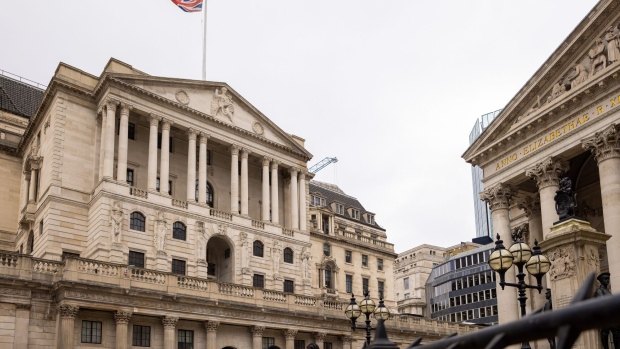Apr 4, 2024
Britain’s Falling Money Supply Clouds Chance of a Brisk Rebound
, Bloomberg News

(Bloomberg) -- The UK’s broad measure of money supply continued to fall at the start of 2024, leaving economists who follow the measure warning against any brisk bounce back from a recession that hit last year.
Bank of England data out this week showed that a closely watched measure of M4 money supply declined in the first two months of 2024, sinking 1.1% in February compared to a year ago. The UK is also trailing the bounce backs in money supply seen in the US and eurozone.
The figures are concerning for monetarists, who foresaw both a double-digit surge in inflation and the UK’s technical recession by tracking money supply. While mainstream economists and the central bank anticipate a gentle improvement in the UK economy this year, monetarists are more cautious.
“The numbers need to improve further to warrant sounding the all-clear,” Simon Ward, economic adviser to Janus Henderson, said in an interview. “The first quarter could show a small recovery, but the continued weakness of monetary trends suggests significant risk of a subsequent relapse.”
He and colleagues including Tim Congdon, founder of the Institute of International Monetary Research, see growth and inflation as driven by the quantity of money in circulation and its velocity — how many times it changes hands. The measure gained popularity as a forecasting tool in the 1980s and 1990s but has since fallen out of favor, with economists increasingly relying on surveys of activity and consumer attitudes instead.
Many mainstream economic indicators have pointed to a brightening picture for the UK in recent months, but the money supply data has remained stubbornly lackluster, with only a small pick-up from the final months of 2023.
M4 excluding intermediate other financial corporations — a closely watched measure of money supply — slipped 1.6% year-on-year in January and 1.1% in February, according to BOE data. While that’s an improvement on last year’s tumbles, February still marked the eighth consecutive contraction.
“The six-month rates of change of real broad and narrow money ... are still negative,” said Ward. He is particularly concerned about the “continued weakness of corporate money trends,” which suggest that some companies are under pressure to cut jobs and investment.
Central bankers have played down the significance of the money supply data, though the successful predictions by the unorthodox monetarists have prompted calls for the BOE to watch the figures more closely.
Money supply shot up shortly before inflation surged and hit a high of more than 11% in late 2022. It then collapsed and contracted for the first time in at least 13 years, prompting warnings of recession including from former BOE Governor Mervyn King. Official data has since confirmed that the UK suffered a shallow technical recession in the second half of last year.
Ashley Webb, UK economist at Capital Economics, said the “negative annual growth rate in M4ex leaves the UK looking like a bit of an outlier” compared to rising money supply in the eurozone and the US.
However, he cautioned that the recent trend has been more positive than the annual rate suggests, pointing to recent growth on a three-month annualized basis.
“The relationship between money growth and CPI inflation isn’t very strong,” Webb said. “But at face value the annual growth rate in M4ex points to further falls in UK CPI inflation, to just above zero in around 18 months time.”
BOE Chief Economist Huw Pill recently conceded that it needs to take a “broader approach” to its forecasts, including delving into the money supply figures. A review by former Federal Reserve chair Ben Bernanke into the BOE’s forecasts is due on April 12 after the central bank was criticized for failing to anticipate the scale and persistence of the inflation shock.
©2024 Bloomberg L.P.






